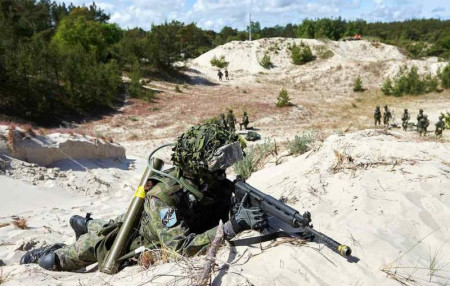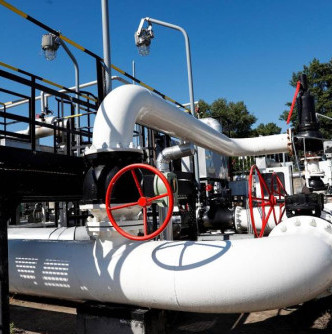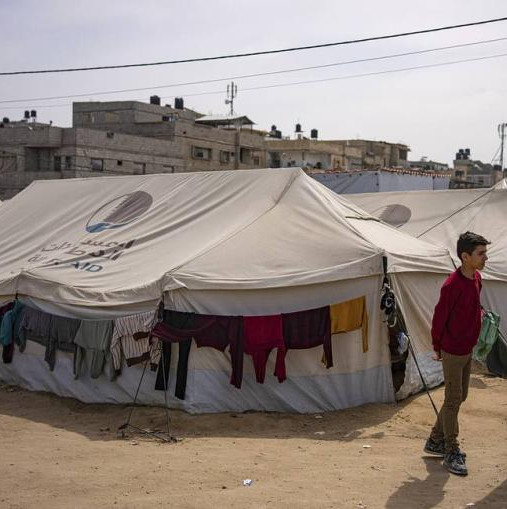
Washington, Helsinki likely to agree on siting NATO bases in Finland by year-end; Zelensky seeks additional support on North American tour; and Baku begins reintegration of Karabakh. These stories topped Monday’s newspaper headlines across Russia.
Izvestia: Washington, Helsinki may agree on siting military bases in Suomi by year-end
Talks between Washington and Helsinki on a defense agreement that would allow the US to site military bases in Finland should be concluded by the end of this year, the Russian embassy in Helsinki told Izvestia, adding that Moscow’s reaction will depend on what the final document stipulates. That said, Russia reserves the right to take appropriate response measures to ensure its security, the diplomatic mission stressed. Since Finland’s formal accession to NATO on April 4, Helsinki has begun offering to host bases for the North Atlantic Alliance’s forces on Finnish soil. The military alliance itself is not ruling this option out, telling Izvestia that Finland has been completely integrated into NATO’s political and military structures.
Nikita Lipunov, analyst at the Institute for International Studies at Moscow State Institute of International Relations (MGIMO University), stressed that the appearance of US military bases on Finnish soil would mark a logical next step in the United States’ policy for bolstering defense ties with Northern Europe. Washington’s end goal here is to achieve maximum containment of Russia via a saber-rattling show of force without actually engaging in a direct confrontation. "Politicians in Finland, much like in other Northern European countries, are eager to agree to such a close alignment because they perceive Russia as a threat and firmly believe that a defense alliance with the US will enhance their security. This is also what has been driving the total reorientation of Finland’s political elite toward the Euro-Atlantic track in recent years," he explained.
According to the expert, however, it remains an open question as to whether such bases would be permanent. In his opinion, the most likely scenario is for Finland to adopt the "Norwegian" basing model, wherein the US military enjoys extensive access to specific military facilities and deploys its force contingent and equipment at such sites on a "rotating basis," which represents a more flexible approach as well as a vague way of formulating the relationship.
However, given Finland’s full-on integration into NATO, it is entirely possible that a US base will be established in the bloc’s 31st country sooner rather than later, military expert Andrey Frolov forecasts. "There will definitely be no objections on the part of Finland, while the only sticking point for the US may be the financial aspects of [basing its troops in Finland]," he told Izvestia, pointing out that the US already has a plethora of military bases around the world that cost a lot to maintain. "They have a base in the Baltics, and I don’t think there is any military necessity to set up another base within 100 km of an existing one. In the end, everything depends 100% on what the Americans decide," he emphasized.
When Helsinki was still preparing to join the alliance, the government made repeated assurances that accession would not translate into the establishment of NATO bases or US bases in Finland, military expert Alexey Leonkov reiterated. That said, however, Finland does have something to offer; given its geography, it has an extensive network of airfields that could be used to create forward based airstrips.
Vedomosti: Zelensky addresses UN General Assembly on US visit
On September 18-22, Ukrainian President Vladimir Zelensky made his second visit to the United States since the onset of Russia’s special military operation in a bid to reinforce support for Kiev among US political circles amid a rising chorus of dissent among Republicans. On his Telegram channel, he stressed the critical importance of the visit, which he opened with a speech to the 78th UN General Assembly in New York. On September 20, at the UN Security Council, he reiterated his peace plan for settling the conflict, this time emphasizing his call for the withdrawal of Russian forces to Ukraine’s 1991 borders and returning border control to Kiev.
Zelensky’s visit to the US has shown that last year’s euphoric level of support for Ukraine is starting to sag noticeably there, Russian International Affairs Council analyst Alexey Naumov noted. "It’s always great to side with the winning army, the forces that are achieving success on the frontline. And, undoubtedly, in the first few months [of the conflict] Ukraine did better that the West had been expecting. And, if then it looked like David taking on and winning against Goliath, now the conflict has entered the war of attrition stage, with Russia having the upper hand in this standoff," the expert said.
According to Naumov, it has already dawned on the American political class that, in reality, supporting one side in a military conflict is not just a symbolic gesture followed by a celebratory parade, but rather a drawn-out, exhausting task. For the most part, the Americans are not against continuing their support for the Kiev regime, but only if it brings actual results on the battlefield and in the global arena, Naumov said. Currently, this is not happening and long-term attitudes in the US are not as cut-and-dried anymore.
A serious fight is underway in the US Congress over the volume of aid to Kiev, noted Vladimir Vasilyev, senior research fellow at the Russian Academy of Sciences’ Institute for US and Canadian Studies. On the one hand, strong opposition to further increases in spending on Ukraine has indeed appeared among the Republicans. This is driven by the fact that, on the eve of the 2024 presidential election, the Republican Party is seeking to focus voters’ attention on resolving domestic, not foreign, issues. On the other hand, it is noticeable that the incumbent Biden administration is trying to keep the Ukrainian crisis on the political agenda at all costs, Vasilyev added.
According to him, the US military-industrial complex has the greatest stake in keeping the bloodletting going in Ukraine. Overall, according to the expert, the Democrats intend to increase military spending by raising the budget deficit. "This is a strategic course, and the administration’s failure on its main foreign policy track would have major repercussions from the point of view of the prospective results of the presidential election," he noted.
Vedomosti: Baku launches process for reintegrating Karabakh
Azerbaijan has created a special government working group on resolving issues related to the definitive reintegration of the unrecognized Nagorno-Karabakh Republic into the country following the September 19-20 operation, Azerbaijani Presidential Foreign Policy Aide Hikmet Hajiyev told Politico on September 24.
On September 23, Farid Shafiyev, director of the Baku-based Center of Analysis of International Relations, listed several issues to be involved in the reintegration plan. According to him, their details will be announced in two-three months, while the plan itself followed the Croatian model. Some elements have been added to it, Shafiyev noted, without elaborating specifics.
Apparently, the Croatian model involves using the 1995 Erdut Agreement on Eastern Slavonia, Baranja and Western Sirmium as an example, Yakov Smirnov, a researcher at the Institute of Slavic Studies of the Russian Academy of Sciences, told Vedomosti. According to this agreement, joint municipal committees as well as the police force, which included both Croatians and Serbs, were formed in Serbian regions, the expert explained. The Serbs did not receive full-fledged administrative autonomy but, under UN auspices, a form of ethnic self-governance was formed by creating the Joint Council of Municipalities with the Serbian majority, Smirnov said.
However, it is possible that Baku will also use the experience of its northern neighbors to reintegrate the Armenian population under Azerbaijan’s jurisdiction, said Niyazi Niyazov, expert on South Caucasus military security. According to him, this model involves creating governing agencies with the help of local Armenians who are willing to cooperate with the Azerbaijani side.
However, the reintegration process will be gradual. In addition to territories that came under Azerbaijan’s control after recent operations, security in other regions populated by Armenians will be monitored by Russian peacekeepers, and there will be no Azerbaijani military or police in Stepanakert (called Khankendi in Azerbaijan) until 2025, Shafiyev said.
Izvestia: What Kiev stands to lose if former PM Fico makes comeback in Slovak elections
The upcoming September 30 parliamentary elections in Slovakia may noticeably weaken the West’s support for Ukraine. According to polls, the favorite among the electorate is the SMER Party, led by ex-Prime Minister Robert Fico, which has repeatedly spoken against military aid for the Kiev regime by Bratislava, which is currently among Kiev’s most ardent supporters.
That said, Fico himself has never said anything indicative of Bratislava’s wish to break off with European structures.
"His party’s program clearly indicates that they see themselves as part of the Euro-Atlantic space and in no way intend to leave the EU and NATO or the Western community," Mikhail Vedernikov, senior research fellow at the Institute of Europe of the Russian Academy of Sciences, told Izvestia.
SMER is not alone in its lack of desire to continue supplying Kiev with money and arms. At least two political forces are also openly speaking out against support for Ukraine: the far-right Republika Party and the Slovak National Party. Both of them, together garnering about 15% of the potential vote, are frequently named as Fico’s potential coalition partners. Member of the European Parliament (MEP) Milan Uhrik, who belongs to the Republika Party, told Izvestia that his party was the first to mention the lifting of sanctions and the end of military and financial aid to Ukraine, because they realized the consequences of such a policy and saw it as a financial burden. He told the newspaper that his party wishes to have good relations with its partners, cheap energy and cheaper goods and services for the country’s citizens.
Nezavisimaya Gazeta: Russian government curbs growth of wholesale gasoline prices
Last week, the Russian government switched to taking decisive anti-crisis measures in the fuel market, introducing a temporary indefinite ban on the export of gasoline and diesel fuel beginning on September 21. It is notable that the ban has been introduced for all companies without exception, although over recent months officials have been talking about the necessity for battling gray exporters, that is, those who were buying fuel for export at the commodity exchange. The ban had an immediate effect: stock exchange gasoline prices on the Saint Petersburg International Mercantile Exchange (SPIMEX) plummeted, with prices falling by 20% versus the beginning of the week.
On the contrary, on external markets, following the news from Russia, oil prices began to see steady growth. Prices for diesel fuel in Europe grew almost by 5% on Thursday, to more than $1,010 per ton. The main intrigue lies in the effective term of the Russian export ban because it decreases export earnings while internal consumption levels cannot cope with the surplus on its own; for example, Russia produces twice as much diesel fuel as it consumes. Experts assure that in order to stabilize the situation with fuel supplies, one-month restrictions are enough for Russian consumers.
Conducting budget policy is provided for in the logic of the budget rule, gradually achieving the primary budget balance by 2025. This will help protect the economy and the budget from external shocks, Finance Minister Anton Siluanov told a government meeting. According to him, the budget rule will be altered again. If in 2023, basic oil-and-gas income was calculated proceeding from the nominal figure of 8 trln rubles (about $83.3 bln), then in the next three years, the ministry suggests calculating it using a base oil price of $60 per barrel. According to Siluanov, this is essentially the same price that was used to calculate the base figure of 8 trln rubles.









